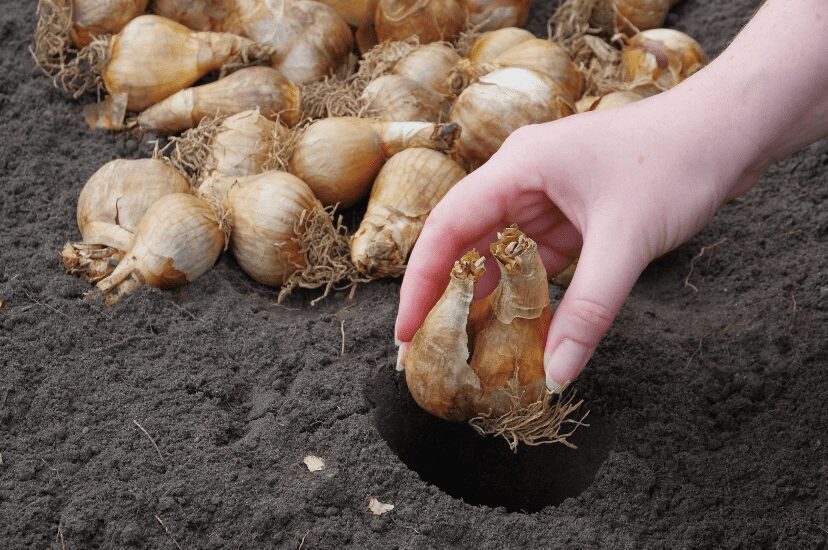
Here are a few exotic summer-blooming bulbs you may buy now. Get them already potted, or bare-root to pot up and grow indoors in a warm, well-lighted area, keeping the soil barely moist — and then put out in the garden after night temperatures stay in the mid-50s (there’s an exception, see below):
Alocasia
The enormous green leaves of Alocasia macrorrhiza look like the ears of elephants and have to be seen to be believed as they wave skyward on 2- to 6-foot stems.
But there’s also Alocasia ‘Hilo Beauty,’ with cream-spotted, parrot-green leaves. And ‘ Alocasia Frydek’ has deep, velvety-green leaves accented with silvery-white veins. Alocasia takes shade or part sun.
Amaryllis Belladonna
Naked Lady is the nickname for this bulb, which sends up straplike leaves that die back in summer and make way for 2-foot-tall bare stems with multiple pink (or the new ‘Alba’ white) blossoms on top.
In USDA Hardiness Zone 7 and farther south, these come back year after year and need very little water. In Zones 5b/6a, try planting them in a hot, south-facing space with extra mulch in winter for a return.
Anemone Coronaria
Here’s an exception. Plant these tubers outside as early in spring as possible for a brilliantly colored, early summer display of 12-inch-tall plants with poppy-like flowers. They take full sun to partial shade.
Caladium
Great for something different in the shade, these tuber-grown plants with elephant-ear or angel-wing foliage have been bred in Florida for more substance and thicker leaves.
Look for the white, pink, and magenta leaves of ‘Florida Fantasy’ or the speckled chartreuse leaves of ‘Miss Muffett.’ And among the newest are the Gingerland series of dwarfs, at 6 to 8 inches tall, with particularly showy leaves in red, pink, white, and green.
Canna
This 2- to 10-foot-tall tropical, with lance-shaped leaves and big, multicolored flowers, might be what started the tropical revival. The red Canna ‘President’ was a hot seller last year.
This year it may be the equally red ‘King Humbert,’ the lemon-yellow ‘Picasso,’ the bright yellow ‘Richard Wallace,’ or the brilliant orange ‘Pretoria,’ the latter complete with yellow-and-green striped foliage. The rhizome-grown plants like full sun.
Colocasia
This tropical thrives in St. Louis’ heat and humidity. Look at ‘Black Magic’ or the newer ‘Black Runner.’ And don’t miss the black- over-lime-green ‘Illustris’ or the vast, cream-on-green leaves of ‘Nancy’s Revenge.’
Dahlia
Some garden centers haven’t carried dahlias for years. Now they’re back, in big dinner-plate sizes, standing 3 to 4 feet tall. They are semi-hardy here in mild winters but must have their tuberous roots dug up and stored indoors in winter.
Collectors are going for the massive flowers of the Dahlias ‘Hawaii’, ‘ Le Baron’, or ‘Bishop of Llandaff.’
Lilium
The white ‘Casa Blanca’ and red ‘Star Gazer’ lilies are very common- but expensive to buy as cut flowers. So grow them in your garden. Also, look at the lavender ‘Aruba,’ the hot pink ‘Kissproof,’ and the new ‘Golden Star Gazer.’
They start as scaly bulbs but produce upright stems with narrow, lance-shaped leaves and, in early summer, fragrant, funnel-shaped flowers.
Use them to fill empty, sunny spots in your perennial beds or to make striking centerpieces in containers with companion plants. Be sure that the soil or medium potting drains well.
FAQs
What are some exotic summer-blooming bulbs that can be purchased now?
Some exotic summer-blooming bulbs that can be purchased now include Alocasia, Amaryllis Belladonna, Anemone Coronaria, Caladium, Canna, Colocasia, Dahlia, and Lilium.
Can Alocasia be grown indoors?
Alocasia can be grown indoors in a warm, well-lighted area, keeping the soil barely moist before being put out in the garden after night temperatures stay in the mid-50s.
What is the nickname for Amaryllis Belladonna?
The nickname for Amaryllis Belladonna is Naked Lady.
What type of environment does Anemone Coronaria prefer?
Anemone Coronaria prefers full sun to partial shade and should be planted outside as early in spring as possible for a brilliantly colored, early summer display of 12-inch-tall plants with poppy-like flowers.
Can Dahlia plants survive mild winters?
Dahlia plants are semi-hardy in mild winters but must have their tuberous roots dug up and stored indoors in winter.
Can Caladium be grown in full sun or shade?
Caladium can be grown in shade or part sun, making them great for something different in shady areas.
What is the recommended planting time for Anemone Coronaria?
Anemone Coronaria should be planted outside as early in spring as possible to ensure a brilliantly colored, early summer display of poppy-like flowers.
How should the soil be watered for Alocasia?
The soil for Alocasia should be kept barely moist while being grown indoors in a warm, well-lighted area.
Can Lilium bulbs be planted in containers?
Lilium bulbs can be planted in containers with companion plants to make striking centerpieces. Be sure that the soil or medium potting drains well.
Do all Dahlia varieties grow to be 3 to 4 feet tall?
Not all Dahlia varieties grow to be 3 to 4 feet tall. However, the ones mentioned in the text, such as ‘Hawaii,’ ‘Le Baron,’ and ‘Bishop of Llandaff,’ are known for their massive flowers and tall stature.
Conclusion
Several exotic summer-blooming bulbs can be purchased and grown indoors or outdoors. From the enormous green leaves of Alocasia to the multiple pink blossoms on top of Amaryllis Belladonna, there are many unique options to choose from.
Anemone Coronaria is an exception, as it should be planted outside as early in spring as possible for a brilliantly colored, early summer display.
Caladium and Colocasia are great options for shade or part sun, while Canna and Lilium prefer full sun.
Dahlia, which has made a comeback in recent years, can be planted in the ground or containers, with some varieties known for their massive flowers and tall stature.
Gardeners can enjoy a beautiful and unique summer display by choosing the right bulbs and providing the right growing conditions.

























